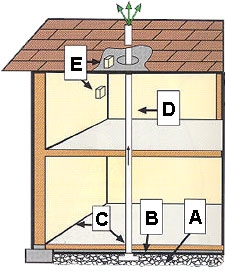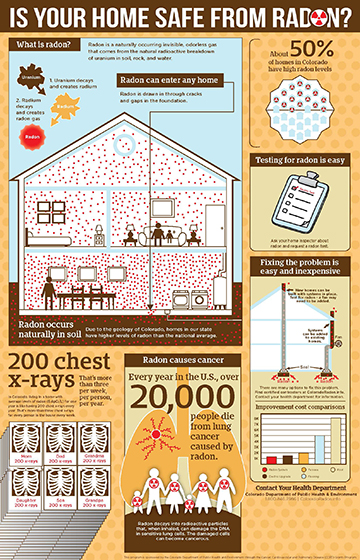Radon-Resistant Construction
Radon-Resistant Construction is the installation of a “passive” radon mitigation system during the construction of a new single- or multi-family home. A “passive” system does not include a radon mitigation fan. When properly installed these systems can lower indoor radon levels by about 50%. Some “passive” systems may require the addition of a fan if radon levels are elevated. For example, in a home with a radon level of 10.0 pCi/L the radon would only be lowered to 5.0 pCi/L by a properly functioning “passive” system.
Construction Techniques

Radon-Resistant Construction techniques may vary, depending on the foundation and site requirements. A building constructed to radon-resistant standards will include these basic elements:
A. Gas-Permeable Layer – a layer placed beneath the slab or flooring system allows the soil gas to move freely beneath the building. In many cases, the material used is a 4-inch layer of clean gravel.
B. Plastic Sheeting – plastic sheeting placed on top of the gas-permeable layer and under the slab helps prevent the soil gas from entering the building. In crawlspaces, the sheeting is placed over the crawlspace floor.
C. Sealing & Caulking – sealed openings in the concrete foundation floor reduce soil gas entry into the building.
D. Vent Pipe – a 3- or 4-inch gas-tight or PVC pipe (commonly used for plumbing) running from the gas-permeable layer through the building extending above the roof ensures that radon and other soil gases are safely ventilated above the building.
E. Junction Box – an electrical junction box is installed in case a fan is needed later to reduce building radon levels below 4.0pCi/L.
Radon-resistant construction techniques can not only reduce radon levels, but can also decrease soil moisture. This helps reduce mold, mildew, and odors, especially when a “passive” system is activated with a radon reduction fan.
Local Requirements
Currently in Boulder County, new single-family homes must be built with Radon-Resistant Construction in the following municipalities:
- The City of Boulder
- The City of Longmont
- The City of Louisville
- The Town of Erie
- The Town of Superior
- Unincorporated Boulder County
Testing After Occupancy
A new home constructed with Radon-Resistant Construction should be tested for radon as soon as possible after move-in. This is to ensure the “passive” system is lowering the radon levels in the building below 4.0 pCi/L. If testing shows a level of 4.0 pCi/L or higher, a fan can be added to the system to reduce the radon levels. After the addition of a fan, the home will need to be retested to make sure the fan is operating properly and lowering the radon levels below 4.0 pCi/L.
Contact your building department for information about radon test kits for new homes built with Radon-Resistant Construction.




